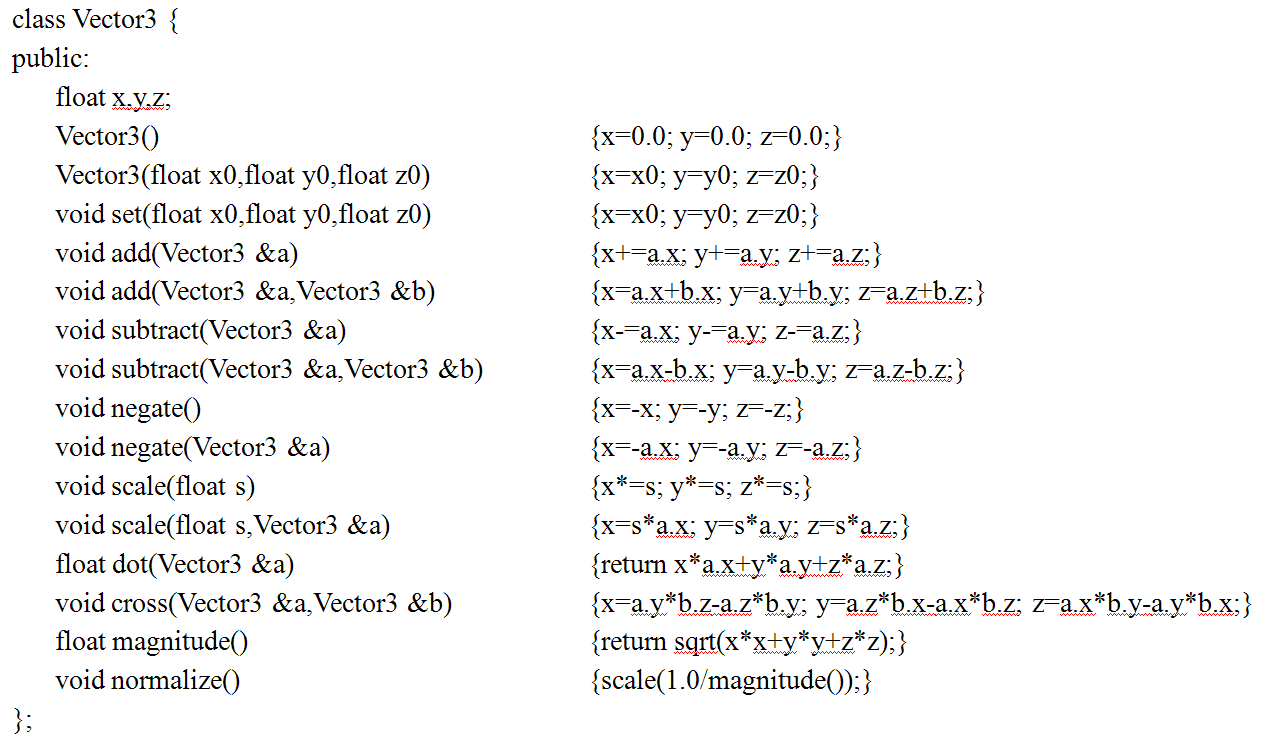Difference between revisions of "Project1Fall12"
(New page: =Project 1: Vectors, Matrices, and Coordinate Transformations= Your project should build on the provided base code. Before you start with this project, you will ne...) |
(→1a. Vectors (One point for each method for a total of 25 points)) |
||
| Line 19: | Line 19: | ||
[[Image:sample-vector-class.png]] | [[Image:sample-vector-class.png]] | ||
| − | ===1a. Vectors ( | + | ===1a. Vectors (Two points for each method for a total of 30 points)=== |
Implement the following methods in your <tt>Vector3</tt> class: | Implement the following methods in your <tt>Vector3</tt> class: | ||
Revision as of 06:34, 28 September 2012
Contents |
Project 1: Vectors, Matrices, and Coordinate Transformations
Your project should build on the provided base code. Before you start with this project, you will need to look through the base code and get familiar with it.
This project has three parts, but only the first two are mandatory to get full credit (100 points). The number of points you can get for each part is indicated below. In the first part you will create classes for vectors and matrices. You will use this functionality in the remaining projects throughout the quarter. In the second part of this project you will construct an animated object that consists of several parts that move with respect to each other.
The third part is optional. We make suggestions for how to extend your solution with some additional features. You will get extra credit for completing those.
Note that in this project you are not allowed to use OpenGL or GLUT matrix routines, such as glRotate, glTranslate, or glScale, because we want you to use your own matrix routines.
This project is due on Friday, October 5th. You will need to present your project in the lab starting at 1:30pm that day, or during one of the TA/tutors' office hours before that day. For this project you are allowed to work in teams of two. In this case both team members need to be present during the homework presentation.
The TA, Sid Vijay, is going to introduce this homework assignment in lab 260 on Monday, October 1st at 2:30pm in lab 260.
1. Vectors and Matrices
Implement a basic matrix and vector library by extending the classes in the base code. You can use the C++ class shown below as a basis. Create separate classes for a Vector3 and a Vector4 type, with three or four components, respectively. The Vector4 type describes points. The matrix class should be for 4x4 matrices.
1a. Vectors (Two points for each method for a total of 30 points)
Implement the following methods in your Vector3 class:
- A constructor with three parameters being the components of the vector
- Element access 'set': set the components of the vector
- Element access 'get': return a specific element of the vector
- Overload operator '[]' for 'get' access
- Vector addition
- Overload operator '+' for addition
- Vector subtraction
- Overload operator '-' for subtraction
- Negation
- Scale (multiplication with scalar value)
- Dot product
- Cross product
- Magnitude (length of vector)
- Normalize
- Print (display the vector's components numerically on the screen)
Implement the following methods in your Vector4 class:
- A constructor with three parameters being the components of the point
- Element access 'set': set the (four) components of the point
- Element access 'get': return one of the four components of the point
- Overload operator '[]' for 'get' access
- Vector addition
- Overload operator '+' for addition
- Vector subtraction
- Overload operator '-' for subtraction
- Dehomogenize (make fourth component equal to 1)
- Print (display the point's components numerically on the screen)
1b. Matrices (Two points for each method for a total of 20 points)
Implement the following methods in your Matrix4 class:
- Constructor with 16 parameters to set the values of the matrix
- Multiply (matrix-times-matrix)
- Multiply (matrix-times-vector): if multiplying with a point, dehomogenize the result after the multiplication
- Make rotation matrix about x axis
- Make rotation matrix about y axis
- Make rotation matrix about z axis
- Make rotation matrix about arbitrary (unit) axis
- Make non-uniform scaling matrix
- Make translation matrix
- Print (display all 16 matrix components numerically on the screen in a 4x4 array)
2. Animated Object (50 points)
Construct an animated object that consists of at least three parts. You can use simple boxes and transform them appropriately. Use at least one sphere in the model which you construct with the algorithm from part 2. Make an animation where at least three parts move with respect to each other. For example:
- A car with turning "wheels" (made of boxes), moving in a circle on a ground plane.
- A helicopter with spinning rotor blades, flying in a circle.
- An industrial robot with a rotating saw, each rigid section made of a box.
- The moon rotating about the earth, which rotates about the sun.
You will get full credit if you have an object that moves in a circle (15 points), and that has moving parts itself (rotating rotor blades, wheels, etc.) (15 points). In addition, the boxes and spheres need to be transformed (e.g., by non-uniform scaling) to approximate the desired shapes (e.g., elongated rotor blades, rectangular car body) (5 points). To make the shapes look more interesting and distinguishable, give them or individual faces different colors (5 points).
You are explicitly allowed to use OpenGL utility and GLUT geometry creation functions (such as gluSphere, glutSolidCone, glutSolidTorus, glutSolidSphere, glutWireSphere) in this homework project.
3. Optional Features (up to 10 points)
- Write code to generate additional geometry, for example cylinders, tori, or cones (4 points each).
- Move objects along ellipses rather than circles (elliptical motion needs to be obvious) (3 points).
